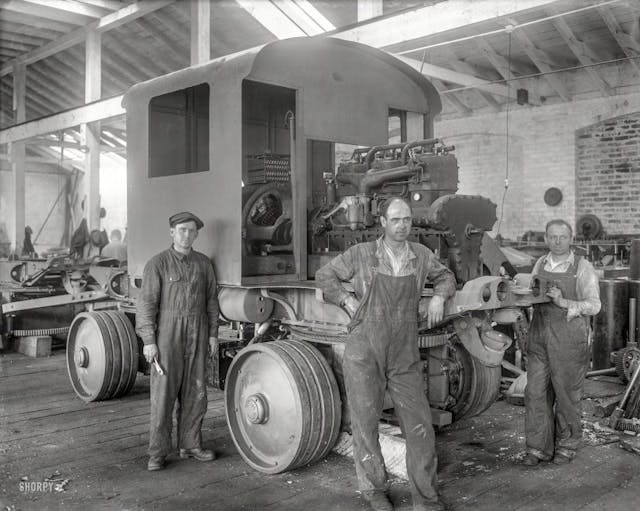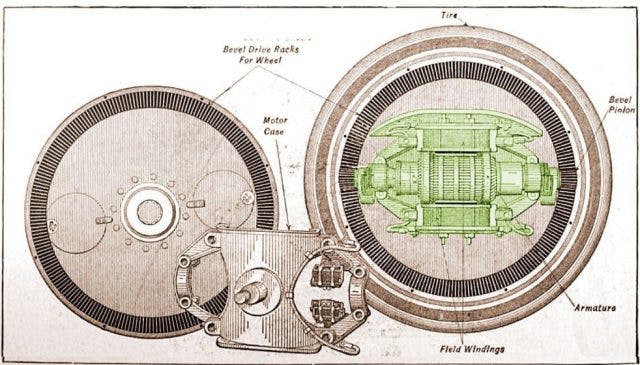4 forgotten 4x4s that some enthusiasts may actually remember
Nobody remembers the one millionth red light they’ve stopped at, but everyone remembers the first time they got stuck in the mud in a 4×4—or how a 4×4 helped them discover new places that would’ve been practically impossible to explore on foot without a weeks-long hike. It’s the 4×4’s ability to traverse seemingly impassible barriers that makes them so memorable. Most of them, anyway.
Leaving aside the popular Jeep Wranglers and Toyota Hiluxes are some forgotten 4x4s of the past, those that sank into obscurity more through the failures of our own memories than any mechanical maladies on their part.
Today we’re digging into the depths of our minds, sifting through the broad spectrum of giant earth-movers and fly-weight hooliganism, and selecting our four favorite forgotten 4x4s.
1904 Couple-Gear Freight Company

Four-wheel steering? Sure, why not. Four-wheel drive? Of course. Hybrid driveline with regenerative braking? I mean, that sounds normal for today—but in 1905, when the Couple-Gear Freight Company began building impressive five-ton trucks, none of this was really heard of. The Grand Rapids, Michigan-based builder began experimenting with 4×4 trucks after producing a simple two-wheel drive version with their own hub motor design. Taking the powered and steering front axle and hanging it under the rear, the five-ton trucks gained a reputation for their immense hauling capability along with the freak show trick of being able to drive nearly horizontal into tight parking spaces, thanks to the near 90-degree steering angle that the in-wheel hub motors allowed without the limitations of such things as axle shafts and chain-drives. Compact motors were installed horizontally in the wheel, with a small pinion gear on the motor driving a massive ring gear built into the rim of the wheel with a 25:1 ratio.


The initial trucks were all-electric, giving the five-tonners about 40 miles of range at speeds of up to 6 mph. A year later, however, the Couple-Gear Freight Company would gain a unique customer, which drove the development for a true earth mover to haul the Carnegie Institute’s 60-inch diameter telescope up the 5715-foot summit of Mt. Wilson. Knowing that range would be a problem on such an enduring climb, the engineers toyed with several ideas on how to support the truck’s trip up-hill, including building temporary charging stations along the route.

By this point, gas/electric hybrids such as the Lohner-Porsche had been pioneered, replacing the rudimentary batteries with an engine and generator. The new driveline made the Couple-Gear chassis a favorite for fire engines and mining operations, and the vehicles’ ability to act as mobile generators was also a key factor in an era where electricity was still largely a luxury.
Monteverdi Safari

When we think about how the Swiss engineer their wares, we tend to hold their mechanical creations as a gold standard. What do we think of when something is so finely designed for utility that it can seemingly solve any issue? We call it the Swiss Army knife of … What about a mechanism so precise that it should be impossible to distrust it? We say, It works like a Swiss watch. So, naturally, when the Swiss needed a foundation for a high-performance, luxury SUV—it chose the International Scout.

The 1979–82 Monteverdi Safari utilized the running gear of America’s humble Scout underneath a custom-built frame and body, even carrying over a selection of Chrysler and International V-8s to stuff under the Italian-stamped hood. You had a choice of the basic 318-cubic-inch engine to start, a modest 150 hp or so—enough to shove it to those Buick-powered Range Rovers to the side in a race for the country club’s valet. The 395-cu-in “Comanche” V-8 from International was also carried over as the mid-spec engine at 165 horses, though the real treat here was the 300-hp Chrysler 440-cu-in big-block, bringing the top speed well above 120 mph. As the brochure read, “The Monteverdi Safari’s technical concept is impressive as it is logical.”
We’re not sure if doing a buck-twenty in what essentially boils down to a well-dressed Scout is exactly logical, but to F1 racer and constructor Peter Monteverdi, it was sensible enough to pursue until he ran out of parts, since International retired the Scout in ’82.
GAZ-61

The USSR’s Gorkovsky Avtomobilny Zavod (GAZ) ironically started off by building licensed Ford clones in order to jumpstart the country’s automotive industry, saving the Russian company millions in development and tooling costs as Ford shared notes with the newly formed automaker. While paved road networks in most countries were beginning to spur from border to border, the Soviets were largely reliant on rough trails and endless tundra to get around, and a strange concoction of 4×4 sedans became a fixture during the mid- 20th century.
Taking the Ford Model-B based GAZ-11 and slapping a solid-front axle underneath, GAZ was able to quickly build a machine capable of carrying citizens and Red Army elite. A 3.4-liter inline-six was sourced from the Dodge D5 and produced somewhere around 75 hp, a massive improvement over the flathead four-cylinders that had come from Ford. This concoction of traction was also one of the last Ford-based USSR vehicles to be produced, as the region began seeking its own designs and factories that were better suited for the relentless Russian winters.
Daihatsu Rocky

Daihatsu as a whole might be forgotten by most these days, but during its five-year attack on the small-SUV market, the slab-sided Daihatsu Rocky left its mark against the likes of Jeep, Nissan, Toyota, and Suzuki. The matchbox-sized 4×4 featured sturdy solid axles fore and aft, along with a traditional five-speed manual backed by a proper two-speed transfer case, much like its counterparts from Japan. Power, if you want to call it that, came from a 1.6-liter, single-jingle four-cylinder that eventually managed to barely crack 95 hp in its later years. As with so many other fun-roaders at the time, like the Toyota 4 Runner and Suzuki Samari, the SUV could even be quickly disassembled with a removable hardtop and targa roof.

It had all the right pieces of a legendary 4×4, but Daihatsu’s rocky entrance into the American market was too short-lived for it to stain our nostalgia like so many other Japanese off-roaders. Entering the game in 1988, Daihatsu was late to American shores, and by then streets were flooded with many of the aforementioned Rocky competitors. It didn’t help either that Daihatsu’s only other model, the Charade, was as uninspired to look at as it was to drive, especially compared to Honda’s hot-hatch Si. By 1993, the charade was up, and Daihatsu pulled all distribution efforts from America. The Rocky managed to survive a few more years; it was replaced at the end of the ’90s by the generic jelly bean known as the Terios.
Weirdly, Italy’s Bertone design house would take in the Rocky as a rebranding project, along with BMW, to produce the Freeclimber—complete with BMW’s own selection of gas and diesel engines instead of the quant Daihatsu mill. Remember those?

